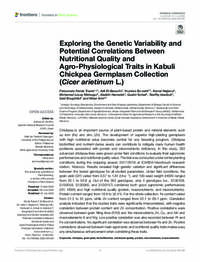Exploring the Genetic Variability and Potential Correlations Between Nutritional Quality and Agro-Physiological Traits in Kabuli Chickpea Germplasm Collection (Cicer arietinum L.)

Authors:
Chickpea is an important source of plant-based protein and mineral elements such as iron (Fe) and zinc (Zn). The development of superior high-yielding germplasm with high nutritional value becomes central for any breeding program. Chickpea biofortified and nutrient-dense seeds can contribute to mitigate many human health problems associated with protein and micronutrients deficiency. In this study, 282 advanced chickpea lines were grown under field conditions to evaluate their agronomic performances and nutritional quality value. The trial was conducted under winter planting conditions during the cropping season 2017/2018 at ICARDA-Marchouch research station, Morocco. Results revealed high genetic variation and significant differences between the tested genotypes for all studied parameters. Under field conditions, the grain yield (GY) varied from 0.57 to 1.81 (t.ha–1), and 100-seed weight (HSW) ranged from 23.1 to 50.9 g. Out of the 282 genotypes, only 4 genotypes (i.e., S130109, S130058, S130066, and S130157) combined both good agronomic performances (GY, HSW) and high nutritional quality (protein, macronutrients, and micronutrients). Protein content ranged from 18.9 to 32.4%. For the whole collection, Fe content varied from 31.2 to 81 ppm, while Zn content ranged from 32.1 to 86.1 ppm. Correlation analysis indicated that the studied traits were significantly intercorrelated, with negative correlation between protein content and Zn concentration. Positive correlations were observed between grain filling time (F2M) and the micronutrients Zn, Cu, and Mn and macroelements K and Mg. Low positive correlation was also recorded between Pr and Fe concentrations. No significant correlation was observed between Fe and Zn. Positive correlations observed between main agronomic and nutritional quality traits makes easy any simultaneous enhancement when combining these traits.
